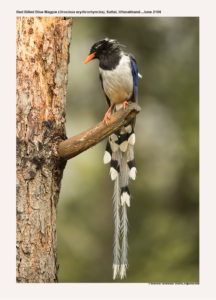
Red-billed Blue Magpie Urocissa erythrorhyncha
Etymology:
- Urocissa : Greek word oura-tail; kissa-magpie
- Erythrorhyncha : Greek word eruthros red; rhunkhos { Red Billed}
Vernacular Names: U.P.: Nilkanth, H.P.: Digdal
Distribution in India: Resident of Himalayas and North East India.
Description:
Size of 65-68 cm; wt. of male 145–192 g, female 106–155 g. It is a highly distinctive blue magpie with exceptionally long, strongly graduated, sweeping white-spotted tail, central feather pair projecting beyond next and drooping towards tip; bill rather prominent, nostrils concealed by soft plumes. The nominate race has head down to upper breast and upper mantle velvety black, feathers of rear crown and nape with extensive white tips. The feathers of forecrown also with tiny whitish tips; upperparts dull medium-blue with weak mauve wash, uppertail-coverts with narrow whitish subterminal bars and black tips; upperwing brighter blue with stronger mauve tones, tips of primaries and secondaries narrowly whitish with narrow dark subterminal lines. The tail is mauve-blue, feathers with broad white tips and black subterminal bars, white tips progressively more extensive towards shorter outermost feathers; underparts below upper breast whitish, washed lightly with grey, undertail-coverts whiter; iris dark brown; bill and legs reddish-pink to coral-red. Both the sexes are similar.
Habitat :
It is found in Tropical and subtropical broadleaf evergreen forest in Himalayan foothills. Found from sea level, up to 2200 m.
Food Habits:
It eats larger invertebrates, especially beetles, caterpillars, land-leeches, tree-frogs, small lizards, birds’ eggs and nestlings, and even small mammals, carrion and kitchen scraps. Variety of fruits and berries are also eaten. It forages at all levels, including forest floor, where it jumps about with tail raised, the very tip drooping
Breeding Habits:
Breeds in April-Jun in India. The nest is built by both sexes. The nest is made up of sticks and twigs, cup lined with fine rootlets and plant fibers, above ground inside upper canopy of sapling or near end of long bough of larger tree.They lay a clutch 3-6 eggs. The female parent incubates. The male feeds incubating female at nest and helps to feed nestlings.